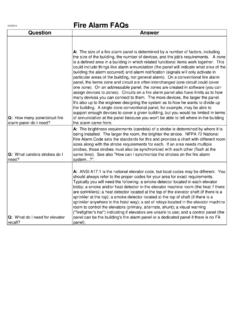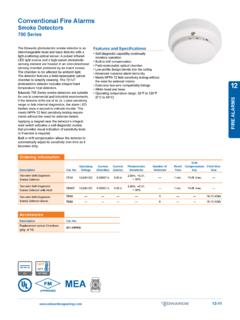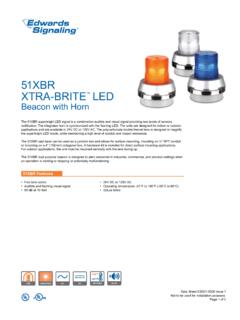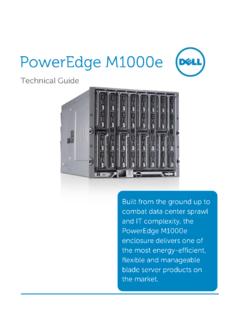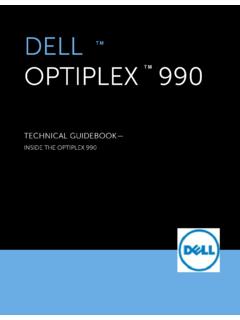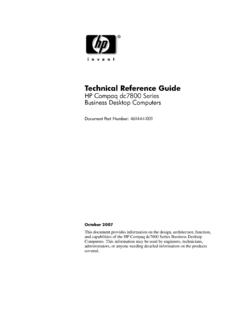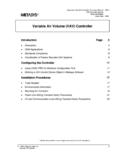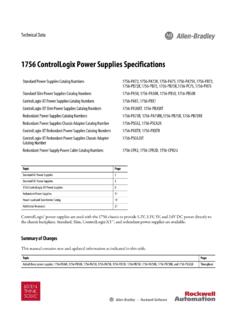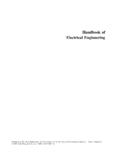Transcription of 3100485-EN R04 Remote Booster Power Supply …
1 Remote Booster Power Supply technical reference Manual P/N 3100485-EN REV 04 ISS 28 AUG12 Copyright 2012 UTC Fire & Security. All rights reserved. Trademarks and patents The Remote Booster Power Supply name and logo are trademarks of UTC Fire & Security. Other trade names used in this document may be trademarks or registered trademarks of the manufacturers or vendors of the respective products. Manufacturer Edwards, A Division of UTC Fire & Security Americas Corporation, Inc. 8985 Town Center Parkway, Bradenton, FL 34202, USA Certification FCC compliance Class A: This equipment has been tested and found to comply with the limits for a Class A digital device, pursuant to part 15 of the FCC Rules. These limits are designed to provide reasonable protection against harmful interference when the equipment is operated in a commercial environment. This equipment generates, uses, and can radiate radio frequency energy and, if not installed and used in accordance with the instruction manual, may cause harmful interference to radio communications.
2 Operation of this equipment in a residential area is likely to cause harmful interference in which case the user will be required to correct the interference at his own expense. FDNY NYC Fire Department Certificate of Approval: MEA 476-91-E XIII European Union directives 1999/5/EC (R&TTE directive): Hereby, UTC Fire & Security declares that this device is in compliance with the essential requirements and other relevant provisions of Directive 1999/5/EC. 2002/96/EC (WEEE directive): Products marked with this symbol cannot be disposed of as unsorted municipal waste in the European Union. For proper recycling, return this product to your local supplier upon the purchase of equivalent new equipment, or dispose of it at designated collection points. For more information see: 2006/66/EC (battery directive): This product contains a battery that cannot be disposed of as unsorted municipal waste in the European Union.
3 See the product documentation for specific battery information. The battery is marked with this symbol, which may include lettering to indicate cadmium (Cd), lead (Pb), or mercury (Hg). For proper recycling, return the battery to your supplier or to a designated collection point. For more information see: Contact information For contact information, see Remote Booster Power Supply technical reference Manual i Content Important information iii Limitation of liability iii Remote Booster Power Supply FCC compliance iv Introduction 1 Models covered 1 Compatibility 1 Installation procedure checklist 2 Getting started 3 Description 3 Component descriptions 4 Specifications 5 LED indicators 6 Installing the enclosure 7 Installing option modules in the enclosure 8 Installing the circuit board in the enclosure 10 Setting the jumpers 12 NAC Class A or Class B (JP1 and JP2) 12 Ground fault enable (JP3) 12 Battery charging (JP4) 13 UL 864 programming requirements 14 Setting the DIP switches 15 Sense 1 and 2 operation (SW1-1 to 3) 15 Synchronization control (SW1-4) 16 NAC circuit operation (SW1-5 to 8 and SW2-1 to 4)
4 17 Genesis mode for continuous NACs (SW2-5) 19 AC Power loss reporting (SW2-6) 19 Auxiliary control during AC Power loss (SW2-7) 19 Class A or B NAC configuration (SW2-8) 20 ii Remote Booster Power Supply technical reference Manual Wire routing 21 Connecting the field wiring 22 AC Power wiring 22 Battery wiring 22 NAC Class B wiring 24 NAC Class A wiring 25 Sense circuit wiring 26 AUX Power wiring 26 Common trouble relay wiring 27 NAC wiring using CC1(S) modules 29 Installing the 3-TAMP tamper switch 34 Battery calculation worksheet 35 Notification appliance circuit calculations 37 Introduction 37 What you ll need 37 Worksheet method 39 Equation method 40 Understanding BPS synchronization 43 Connection of Booster Power supplies 43 Synchronization of visible outputs 44 Synchronization of visible and audible outputs 44 Applications 46 Key 46 Genesis circuit notification 47 Conventional visible and audible circuit notification 48 Conventional visible and audible circuit to Genesis notification 49 Conventional audible or visible circuit to Genesis notification 50 Genesis visible circuit and conventional audible circuit to Genesis notification 51 Conventional split mode circuit with fault tolerance notification 52 Genesis split mode circuit with fault tolerance notification 53
5 CDR-3 Coder to Genesis notification 54 CDR-3 Coder to conventional notification 55 CDR-3 Coder to Genesis visibles and conventional audibles 56 Access control Power Supply 57 Remote Booster Power Supply technical reference Manual iii Important information Limitation of liability To the maximum extent permitted by applicable law, in no event will UTCFS be liable for any lost profits or business opportunities, loss of use, business interruption, loss of data, or any other indirect, special, incidental, or consequential damages under any theory of liability, whether based in contract, tort, negligence, product liability, or otherwise. Because some jurisdictions do not allow the exclusion or limitation of liability for consequential or incidental damages the preceding limitation may not apply to you. In any event the total liability of UTCFS shall not exceed the purchase price of the product.
6 The foregoing limitation will apply to the maximum extent permitted by applicable law, regardless of whether UTCFS has been advised of the possibility of such damages and regardless of whether any remedy fails of its essential purpose. Installation in accordance with this manual, applicable codes, and the instructions of the authority having jurisdiction is mandatory. While every precaution has been taken during the preparation of this manual to ensure the accuracy of its contents, UTCFS assumes no responsibility for errors or omissions. Advisory messages Advisory messages alert you to conditions or practices that can cause unwanted results. The advisory messages used in this document are shown and described below. WARNING: Warning messages advise you of hazards that could result in injury or loss of life. They tell you which actions to take or to avoid in order to prevent the injury or loss of life.
7 Caution: Caution messages advise you of possible equipment damage. They tell you which actions to take or to avoid in order to prevent the damage. Note: Note messages advise you of the possible loss of time or effort. They describe how to avoid the loss. Notes are also used to point out important information that you should read. iv Remote Booster Power Supply technical reference Manual Remote Booster Power Supply FCC compliance This equipment can generate and radiate radio frequency energy. If the equipment is not installed in accordance with this manual, it may cause interference to radio communications. This equipment has been tested and found to comply with the limits for Class A computing devices pursuant to Subpart B of Part 15 of the FCC Rules. These rules are designed to provide reasonable protection against such interference when this equipment is operated in a commercial environment.
8 Operation of this equipment is likely to cause interference, in which case the user, at his own expense, will be required to take whatever measures may be required to correct the interference. Remote Booster Power Supply technical reference Manual 1 Introduction This installation manual is intended for use by installers and field technicians. It provides the installation procedures, wiring diagrams, DIP switch settings, etc. required to install and set up the Remote Booster Power Supply (BPS). Models covered The following table lists the Booster Power Supply models that are covered in this manual. Catalog number Description BPS6A A Booster Power Supply BPS6A/230 A Booster Power Supply BPS6AC A Booster Power Supply MIRBPS6A A Booster Power Supply MIRBPS6A/230 A Booster Power Supply XLS-BPS6A A Booster Power Supply XLS-BPS6A/230 A Booster Power Supply EBPS6A A Booster Power Supply EBPS6A/230 A Booster Power Supply BPS10A 10 A Booster Power Supply BPS10A/230 10 A Booster Power Supply BPS10AC 10 A Booster Power Supply MIRBPS10A 10 A Booster Power Supply MIRBPS10A/230 10 A Booster Power Supply XLS-BPS10A 10 A Booster Power Supply XLS-BPS10A/230 10 A Booster Power Supply EBPS10A 10 A Booster Power Supply EBPS10A/230 10 A Booster Power Supply Compatibility The input circuits of the Booster Power Supply can be connected to 12 VDC or 24 VDC systems.
9 For details about device compatibility, refer to the Remote Booster Power Supply Compatibility List (P/N 3100656). 2 Remote Booster Power Supply technical reference Manual Installation procedure checklist Follow these steps to install and set up the Booster Power Supply (BPS). Verify that all Power and field wiring are de-energized before proceeding. Unpack the equipment. Review the Getting started section. Review the applications: Review the applications to determine how you want to use the BPS. See the Applications section. Prepare the site: Make sure the installation location is free from construction dust and debris and extreme temperature ranges and humidity. Install the enclosure: See Installing the enclosure for enclosure dimensions. Install option modules if required: See Installing option modules in the enclosure. Install the 3-TAMP tamper switch (if one is used): See Installing the 3-TAMP tamper switch.
10 Set the jumpers: See Setting the jumpers. Set the DIP switch options: See Setting the DIP switches. Review wire routing: See Wire routing. Check field wiring for shorts, opens, and grounds. Connect the field wiring: See Connecting the field wiring. Turn on the AC mains Power . Connect the battery compliment. Verify that no defaults are displayed. Test the system for proper operation. Remote Booster Power Supply technical reference Manual 3 Getting started Description The A and 10 A Booster Power supplies are designed to extend the Power capacity of an emergency communication, life safety, fire alarm, security, or access control system. You can activate the BPS from options modules or from a control circuit. It has four independent NAC/AUX circuits that are supervised, when configured for NAC. It is also equipped with a fault relay that you can configure for common trouble (with immediate AC failure indication), or as an AC mains failure indication relay (with delayed output).
